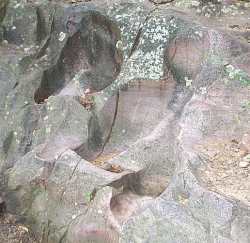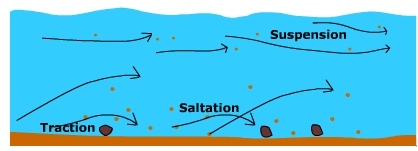18.3: Geologic Work of Streams
- Page ID
- 16642
\( \newcommand{\vecs}[1]{\overset { \scriptstyle \rightharpoonup} {\mathbf{#1}} } \)
\( \newcommand{\vecd}[1]{\overset{-\!-\!\rightharpoonup}{\vphantom{a}\smash {#1}}} \)
\( \newcommand{\id}{\mathrm{id}}\) \( \newcommand{\Span}{\mathrm{span}}\)
( \newcommand{\kernel}{\mathrm{null}\,}\) \( \newcommand{\range}{\mathrm{range}\,}\)
\( \newcommand{\RealPart}{\mathrm{Re}}\) \( \newcommand{\ImaginaryPart}{\mathrm{Im}}\)
\( \newcommand{\Argument}{\mathrm{Arg}}\) \( \newcommand{\norm}[1]{\| #1 \|}\)
\( \newcommand{\inner}[2]{\langle #1, #2 \rangle}\)
\( \newcommand{\Span}{\mathrm{span}}\)
\( \newcommand{\id}{\mathrm{id}}\)
\( \newcommand{\Span}{\mathrm{span}}\)
\( \newcommand{\kernel}{\mathrm{null}\,}\)
\( \newcommand{\range}{\mathrm{range}\,}\)
\( \newcommand{\RealPart}{\mathrm{Re}}\)
\( \newcommand{\ImaginaryPart}{\mathrm{Im}}\)
\( \newcommand{\Argument}{\mathrm{Arg}}\)
\( \newcommand{\norm}[1]{\| #1 \|}\)
\( \newcommand{\inner}[2]{\langle #1, #2 \rangle}\)
\( \newcommand{\Span}{\mathrm{span}}\) \( \newcommand{\AA}{\unicode[.8,0]{x212B}}\)
\( \newcommand{\vectorA}[1]{\vec{#1}} % arrow\)
\( \newcommand{\vectorAt}[1]{\vec{\text{#1}}} % arrow\)
\( \newcommand{\vectorB}[1]{\overset { \scriptstyle \rightharpoonup} {\mathbf{#1}} } \)
\( \newcommand{\vectorC}[1]{\textbf{#1}} \)
\( \newcommand{\vectorD}[1]{\overrightarrow{#1}} \)
\( \newcommand{\vectorDt}[1]{\overrightarrow{\text{#1}}} \)
\( \newcommand{\vectE}[1]{\overset{-\!-\!\rightharpoonup}{\vphantom{a}\smash{\mathbf {#1}}}} \)
\( \newcommand{\vecs}[1]{\overset { \scriptstyle \rightharpoonup} {\mathbf{#1}} } \)
\( \newcommand{\vecd}[1]{\overset{-\!-\!\rightharpoonup}{\vphantom{a}\smash {#1}}} \)
\(\newcommand{\avec}{\mathbf a}\) \(\newcommand{\bvec}{\mathbf b}\) \(\newcommand{\cvec}{\mathbf c}\) \(\newcommand{\dvec}{\mathbf d}\) \(\newcommand{\dtil}{\widetilde{\mathbf d}}\) \(\newcommand{\evec}{\mathbf e}\) \(\newcommand{\fvec}{\mathbf f}\) \(\newcommand{\nvec}{\mathbf n}\) \(\newcommand{\pvec}{\mathbf p}\) \(\newcommand{\qvec}{\mathbf q}\) \(\newcommand{\svec}{\mathbf s}\) \(\newcommand{\tvec}{\mathbf t}\) \(\newcommand{\uvec}{\mathbf u}\) \(\newcommand{\vvec}{\mathbf v}\) \(\newcommand{\wvec}{\mathbf w}\) \(\newcommand{\xvec}{\mathbf x}\) \(\newcommand{\yvec}{\mathbf y}\) \(\newcommand{\zvec}{\mathbf z}\) \(\newcommand{\rvec}{\mathbf r}\) \(\newcommand{\mvec}{\mathbf m}\) \(\newcommand{\zerovec}{\mathbf 0}\) \(\newcommand{\onevec}{\mathbf 1}\) \(\newcommand{\real}{\mathbb R}\) \(\newcommand{\twovec}[2]{\left[\begin{array}{r}#1 \\ #2 \end{array}\right]}\) \(\newcommand{\ctwovec}[2]{\left[\begin{array}{c}#1 \\ #2 \end{array}\right]}\) \(\newcommand{\threevec}[3]{\left[\begin{array}{r}#1 \\ #2 \\ #3 \end{array}\right]}\) \(\newcommand{\cthreevec}[3]{\left[\begin{array}{c}#1 \\ #2 \\ #3 \end{array}\right]}\) \(\newcommand{\fourvec}[4]{\left[\begin{array}{r}#1 \\ #2 \\ #3 \\ #4 \end{array}\right]}\) \(\newcommand{\cfourvec}[4]{\left[\begin{array}{c}#1 \\ #2 \\ #3 \\ #4 \end{array}\right]}\) \(\newcommand{\fivevec}[5]{\left[\begin{array}{r}#1 \\ #2 \\ #3 \\ #4 \\ #5 \\ \end{array}\right]}\) \(\newcommand{\cfivevec}[5]{\left[\begin{array}{c}#1 \\ #2 \\ #3 \\ #4 \\ #5 \\ \end{array}\right]}\) \(\newcommand{\mattwo}[4]{\left[\begin{array}{rr}#1 \amp #2 \\ #3 \amp #4 \\ \end{array}\right]}\) \(\newcommand{\laspan}[1]{\text{Span}\{#1\}}\) \(\newcommand{\bcal}{\cal B}\) \(\newcommand{\ccal}{\cal C}\) \(\newcommand{\scal}{\cal S}\) \(\newcommand{\wcal}{\cal W}\) \(\newcommand{\ecal}{\cal E}\) \(\newcommand{\coords}[2]{\left\{#1\right\}_{#2}}\) \(\newcommand{\gray}[1]{\color{gray}{#1}}\) \(\newcommand{\lgray}[1]{\color{lightgray}{#1}}\) \(\newcommand{\rank}{\operatorname{rank}}\) \(\newcommand{\row}{\text{Row}}\) \(\newcommand{\col}{\text{Col}}\) \(\renewcommand{\row}{\text{Row}}\) \(\newcommand{\nul}{\text{Nul}}\) \(\newcommand{\var}{\text{Var}}\) \(\newcommand{\corr}{\text{corr}}\) \(\newcommand{\len}[1]{\left|#1\right|}\) \(\newcommand{\bbar}{\overline{\bvec}}\) \(\newcommand{\bhat}{\widehat{\bvec}}\) \(\newcommand{\bperp}{\bvec^\perp}\) \(\newcommand{\xhat}{\widehat{\xvec}}\) \(\newcommand{\vhat}{\widehat{\vvec}}\) \(\newcommand{\uhat}{\widehat{\uvec}}\) \(\newcommand{\what}{\widehat{\wvec}}\) \(\newcommand{\Sighat}{\widehat{\Sigma}}\) \(\newcommand{\lt}{<}\) \(\newcommand{\gt}{>}\) \(\newcommand{\amp}{&}\) \(\definecolor{fillinmathshade}{gray}{0.9}\)Water flowing through a stream performs three kinds of geologic work. Moving water erodes material from the bed and sides of the channel, it transports the eroded material to a new location, and then deposits it. Material deposited by streams is called alluvium. The ability of a stream to do work is a function of stream velocity and discharge.
Erosion
Stream erosion is the detachment of material from the bed or sides of the channel. Approximately 95% of a stream's energy is used to overcome frictional effects imposed by the channel and internal molecular friction. This leaves only 5% of the stream's energy for vertical and lateral cutting. Flowing water erodes in three ways. First, flowing water dissolves materials from the channel contributing to stream's dissolved or, solution load. Secondly, the impact of water, or hydraulic action on the sides and bed of the channel dislodges materials and makes them available for transport as part of the stream load. Materials too heavy to suspend, scoot and roll across the bed, eroding the channel by abrasion.

Transportation
Once material is detached from the channel it can be transported. Transportation is the movement of earth material, in this case, by water. As particle size increases, so too does the velocity needed to transport it. The material transported through the stream is it's stream load. Stream load is composed of dissolved or solution load, suspended load, and bed load. The dissolved load comes primarily from groundwater seepage into the stream. Ions in solution also come from the solution of materials that line the channel.
Suspended load is comprised of sediment suspended and transported through the stream. Turbulent flow suspends clay and silt in the stream. Suspended load comes from material eroded from the surface bordering the channel and deposited in the stream, as well as, erosion of the channel itself.

The stream capacity is the maximum load of sediment a stream can carry for a given discharge. As one might expect, stream capacity increases with increasing flow velocity. Increased water velocity imparts a greater frictional drag on bed to erode it. Turbulent flow occurs under higher velocity thus increasing the water's ability to dislodge material from the bed or sides of the stream. Stream competence is the largest size material the stream can move under a given discharge.
Bed load is that which is moved across the bed of the channel. Bed load is transported in two ways, traction, which is a scooting and rolling of particles along the bed. The second is saltation, a bouncing-like movement. Saltation occurs when particles are suspended in the stream for a short distance after which they fall to the bed, dislodging particles from the bed. The dislodged particles move downstream a short distance where they fall to the bed, again dislodging particles upon impact.
Deposition
As velocity and discharge decreases, the ability of the stream to move sediment through it decreases. The heaviest particles deposit on the bed first, with the smaller and lighter particles transported much further before accumulating. Aggradation raises the elevation of the bed by the accumulation of sediment in the channel. Deposits of sand and gravel as bars can separate the channel into numerous smaller channels resulting in a braided channel.
Video: "Stream Aggradation."
Stream flow and work
Figure \(\PageIndex{3}\) shows the relationship between particle size and minimum flow velocity for the three types of geologic work performed by water. Examine the minimum flow velocity for erosion. Note that it is much more difficult to erode materials from the channel than it is to transport or deposit them. For the finest particles like clay, a very high velocity of flow is required to dislodge them from the bed of the channel due to their strong molecular bonding. Small particle don't protrude above the bed of the channel so moving water slips over them more easily than larger particle that stand above the bed more. At the other end of the spectrum, the largest particle require high flow velocities to erode them.

Examine the area of the graph labeled "Transportation". Note that once clays have been eroded they can be transported over a wide range of velocities, even very slow ones before being deposited. The area of the graph for transportation narrows as you move to larger particle sizes. Larger sized material is harder to transport due to their weight.
Take a look at the area of the graph labeled " Deposition". Notice deposition doesn't extend over to the very smallest size on the left. The very smallest particles are easily transported even under low flow velocity and will not settle out. The minimum velocity for deposition (the line that separates transportation and deposition) climbs steadily to the right. This indicates that as particle size and weight increases, it is more difficult to transport material and deposition will occur with a slight drop in stream velocity.


